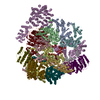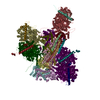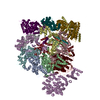[English] 日本語
 Yorodumi
Yorodumi- PDB-5vhi: Conformational Landscape of the p28-Bound Human Proteasome Regula... -
+ Open data
Open data
- Basic information
Basic information
| Entry | Database: PDB / ID: 5vhi | ||||||
|---|---|---|---|---|---|---|---|
| Title | Conformational Landscape of the p28-Bound Human Proteasome Regulatory Particle | ||||||
 Components Components |
| ||||||
 Keywords Keywords | HYDROLASE / p28 / 26S proteasome / regulatory particle / 19S / gankyrin | ||||||
| Function / homology |  Function and homology information Function and homology informationproteasome regulatory particle assembly / Impaired BRCA2 translocation to the nucleus / Impaired BRCA2 binding to SEM1 (DSS1) / thyrotropin-releasing hormone receptor binding / nuclear proteasome complex / host-mediated perturbation of viral transcription / positive regulation of inclusion body assembly / positive regulation of cyclin-dependent protein serine/threonine kinase activity / Hydrolases; Acting on peptide bonds (peptidases); Omega peptidases / integrator complex ...proteasome regulatory particle assembly / Impaired BRCA2 translocation to the nucleus / Impaired BRCA2 binding to SEM1 (DSS1) / thyrotropin-releasing hormone receptor binding / nuclear proteasome complex / host-mediated perturbation of viral transcription / positive regulation of inclusion body assembly / positive regulation of cyclin-dependent protein serine/threonine kinase activity / Hydrolases; Acting on peptide bonds (peptidases); Omega peptidases / integrator complex / proteasome accessory complex / meiosis I / proteasome regulatory particle / cytosolic proteasome complex / positive regulation of proteasomal protein catabolic process / proteasome-activating activity / proteasome regulatory particle, lid subcomplex / proteasome regulatory particle, base subcomplex / protein K63-linked deubiquitination / metal-dependent deubiquitinase activity / negative regulation of programmed cell death / Regulation of ornithine decarboxylase (ODC) / Proteasome assembly / Cross-presentation of soluble exogenous antigens (endosomes) / Homologous DNA Pairing and Strand Exchange / Defective homologous recombination repair (HRR) due to BRCA1 loss of function / Defective HDR through Homologous Recombination Repair (HRR) due to PALB2 loss of BRCA1 binding function / Defective HDR through Homologous Recombination Repair (HRR) due to PALB2 loss of BRCA2/RAD51/RAD51C binding function / Resolution of D-loop Structures through Synthesis-Dependent Strand Annealing (SDSA) / Somitogenesis / K63-linked deubiquitinase activity / Resolution of D-loop Structures through Holliday Junction Intermediates / : / Impaired BRCA2 binding to RAD51 / proteasome binding / negative regulation of release of cytochrome c from mitochondria / transcription factor binding / regulation of protein catabolic process / negative regulation of DNA damage response, signal transduction by p53 class mediator / proteasome storage granule / Presynaptic phase of homologous DNA pairing and strand exchange / general transcription initiation factor binding / positive regulation of RNA polymerase II transcription preinitiation complex assembly / polyubiquitin modification-dependent protein binding / protein deubiquitination / blastocyst development / endopeptidase activator activity / proteasome assembly / mRNA export from nucleus / negative regulation of MAPK cascade / SARS-CoV-1 targets host intracellular signalling and regulatory pathways / enzyme regulator activity / ERAD pathway / regulation of proteasomal protein catabolic process / inclusion body / proteasome complex / TBP-class protein binding / positive regulation of protein ubiquitination / Regulation of activated PAK-2p34 by proteasome mediated degradation / Autodegradation of Cdh1 by Cdh1:APC/C / APC/C:Cdc20 mediated degradation of Securin / N-glycan trimming in the ER and Calnexin/Calreticulin cycle / stem cell differentiation / Asymmetric localization of PCP proteins / Ubiquitin-dependent degradation of Cyclin D / SCF-beta-TrCP mediated degradation of Emi1 / NIK-->noncanonical NF-kB signaling / TNFR2 non-canonical NF-kB pathway / AUF1 (hnRNP D0) binds and destabilizes mRNA / Vpu mediated degradation of CD4 / Assembly of the pre-replicative complex / Ubiquitin-Mediated Degradation of Phosphorylated Cdc25A / Degradation of DVL / Dectin-1 mediated noncanonical NF-kB signaling / Cdc20:Phospho-APC/C mediated degradation of Cyclin A / P-body / Degradation of AXIN / Hh mutants are degraded by ERAD / Activation of NF-kappaB in B cells / Degradation of GLI1 by the proteasome / G2/M Checkpoints / Hedgehog ligand biogenesis / Defective CFTR causes cystic fibrosis / Autodegradation of the E3 ubiquitin ligase COP1 / GSK3B and BTRC:CUL1-mediated-degradation of NFE2L2 / Regulation of RUNX3 expression and activity / Negative regulation of NOTCH4 signaling / Hedgehog 'on' state / double-strand break repair via homologous recombination / Vif-mediated degradation of APOBEC3G / APC/C:Cdh1 mediated degradation of Cdc20 and other APC/C:Cdh1 targeted proteins in late mitosis/early G1 / FBXL7 down-regulates AURKA during mitotic entry and in early mitosis / Degradation of GLI2 by the proteasome / GLI3 is processed to GLI3R by the proteasome / MAPK6/MAPK4 signaling / Degradation of beta-catenin by the destruction complex / double-strand break repair via nonhomologous end joining / Oxygen-dependent proline hydroxylation of Hypoxia-inducible Factor Alpha / ABC-family proteins mediated transport / HDR through Homologous Recombination (HRR) Similarity search - Function | ||||||
| Biological species |  Homo sapiens (human) Homo sapiens (human) | ||||||
| Method | ELECTRON MICROSCOPY / single particle reconstruction / cryo EM / Resolution: 6.8 Å | ||||||
 Authors Authors | Lu, Y. / Wu, J. / Dong, Y. / Chen, S. / Sun, S. / Ma, Y.B. / Ouyang, Q. / Finley, D. / Kirschner, M.W. / Mao, Y. | ||||||
 Citation Citation |  Journal: Mol Cell / Year: 2017 Journal: Mol Cell / Year: 2017Title: Conformational Landscape of the p28-Bound Human Proteasome Regulatory Particle. Authors: Ying Lu / Jiayi Wu / Yuanchen Dong / Shuobing Chen / Shuangwu Sun / Yong-Bei Ma / Qi Ouyang / Daniel Finley / Marc W Kirschner / Youdong Mao /   Abstract: The proteasome holoenzyme is activated by its regulatory particle (RP) consisting of two subcomplexes, the lid and the base. A key event in base assembly is the formation of a heterohexameric ring of ...The proteasome holoenzyme is activated by its regulatory particle (RP) consisting of two subcomplexes, the lid and the base. A key event in base assembly is the formation of a heterohexameric ring of AAA-ATPases, which is guided by at least four RP assembly chaperones in mammals: PAAF1, p28/gankyrin, p27/PSMD9, and S5b. Using cryogenic electron microscopy, we analyzed the non-AAA structure of the p28-bound human RP at 4.5 Å resolution and determined seven distinct conformations of the Rpn1-p28-AAA subcomplex within the p28-bound RP at subnanometer resolutions. Remarkably, the p28-bound AAA ring does not form a channel in the free RP and spontaneously samples multiple "open" and "closed" topologies at the Rpt2-Rpt6 and Rpt3-Rpt4 interfaces. Our analysis suggests that p28 assists the proteolytic core particle to select a specific conformation of the ATPase ring for RP engagement and is released in a shoehorn-like fashion in the last step of the chaperone-mediated proteasome assembly. | ||||||
| History |
|
- Structure visualization
Structure visualization
| Movie |
 Movie viewer Movie viewer |
|---|---|
| Structure viewer | Molecule:  Molmil Molmil Jmol/JSmol Jmol/JSmol |
- Downloads & links
Downloads & links
- Download
Download
| PDBx/mmCIF format |  5vhi.cif.gz 5vhi.cif.gz | 1.7 MB | Display |  PDBx/mmCIF format PDBx/mmCIF format |
|---|---|---|---|---|
| PDB format |  pdb5vhi.ent.gz pdb5vhi.ent.gz | Display |  PDB format PDB format | |
| PDBx/mmJSON format |  5vhi.json.gz 5vhi.json.gz | Tree view |  PDBx/mmJSON format PDBx/mmJSON format | |
| Others |  Other downloads Other downloads |
-Validation report
| Summary document |  5vhi_validation.pdf.gz 5vhi_validation.pdf.gz | 1 MB | Display |  wwPDB validaton report wwPDB validaton report |
|---|---|---|---|---|
| Full document |  5vhi_full_validation.pdf.gz 5vhi_full_validation.pdf.gz | 1 MB | Display | |
| Data in XML |  5vhi_validation.xml.gz 5vhi_validation.xml.gz | 151.2 KB | Display | |
| Data in CIF |  5vhi_validation.cif.gz 5vhi_validation.cif.gz | 235.3 KB | Display | |
| Arichive directory |  https://data.pdbj.org/pub/pdb/validation_reports/vh/5vhi https://data.pdbj.org/pub/pdb/validation_reports/vh/5vhi ftp://data.pdbj.org/pub/pdb/validation_reports/vh/5vhi ftp://data.pdbj.org/pub/pdb/validation_reports/vh/5vhi | HTTPS FTP |
-Related structure data
| Related structure data |  8676MC  8672C  8674C  8675C  8677C  8678C  8679C  8680C  8681C  8682C  8683C  8684C  5vgzC  5vhfC  5vhhC  5vhjC  5vhmC  5vhnC  5vhoC  5vhpC  5vhqC  5vhrC  5vhsC M: map data used to model this data C: citing same article ( |
|---|---|
| Similar structure data | |
| EM raw data |  EMPIAR-10091 (Title: Conformational Landscape of the p28-Bound Human Proteasome Regulatory Particle EMPIAR-10091 (Title: Conformational Landscape of the p28-Bound Human Proteasome Regulatory ParticleData size: 70.0 Data #1: Classified single-particle datasets for multiple conformations of p28-bound human regulatory complex [picked particles - multiframe - processed]) |
| Experimental dataset #1 | Data reference:  10.6019/EMPIAR-10091 / Data set type: EMPIAR / Metadata reference: 10.6019/EMPIAR-10091 10.6019/EMPIAR-10091 / Data set type: EMPIAR / Metadata reference: 10.6019/EMPIAR-10091 |
- Links
Links
- Assembly
Assembly
| Deposited unit | 
|
|---|---|
| 1 |
|
- Components
Components
-26S proteasome regulatory subunit ... , 6 types, 6 molecules ABCDEF
| #1: Protein | Mass: 39395.434 Da / Num. of mol.: 1 Source method: isolated from a genetically manipulated source Source: (gene. exp.)  Homo sapiens (human) / Gene: PSMC2, MSS1 / Production host: Homo sapiens (human) / Gene: PSMC2, MSS1 / Production host:  Homo sapiens (human) / References: UniProt: P35998 Homo sapiens (human) / References: UniProt: P35998 |
|---|---|
| #2: Protein | Mass: 38025.398 Da / Num. of mol.: 1 Source method: isolated from a genetically manipulated source Source: (gene. exp.)  Homo sapiens (human) / Gene: PSMC1 / Production host: Homo sapiens (human) / Gene: PSMC1 / Production host:  Homo sapiens (human) / References: UniProt: P62191 Homo sapiens (human) / References: UniProt: P62191 |
| #3: Protein | Mass: 43201.078 Da / Num. of mol.: 1 Source method: isolated from a genetically manipulated source Source: (gene. exp.)  Homo sapiens (human) / Gene: PSMC5, SUG1 / Production host: Homo sapiens (human) / Gene: PSMC5, SUG1 / Production host:  Homo sapiens (human) / References: UniProt: P62195 Homo sapiens (human) / References: UniProt: P62195 |
| #4: Protein | Mass: 41723.801 Da / Num. of mol.: 1 Source method: isolated from a genetically manipulated source Source: (gene. exp.)  Homo sapiens (human) / Gene: PSMC4, MIP224, TBP7 / Production host: Homo sapiens (human) / Gene: PSMC4, MIP224, TBP7 / Production host:  Homo sapiens (human) / References: UniProt: P43686 Homo sapiens (human) / References: UniProt: P43686 |
| #5: Protein | Mass: 43112.707 Da / Num. of mol.: 1 Source method: isolated from a genetically manipulated source Source: (gene. exp.)  Homo sapiens (human) / Gene: PSMC6, SUG2 / Production host: Homo sapiens (human) / Gene: PSMC6, SUG2 / Production host:  Homo sapiens (human) / References: UniProt: P62333 Homo sapiens (human) / References: UniProt: P62333 |
| #6: Protein | Mass: 42467.867 Da / Num. of mol.: 1 Source method: isolated from a genetically manipulated source Source: (gene. exp.)  Homo sapiens (human) / Gene: PSMC3, TBP1 / Production host: Homo sapiens (human) / Gene: PSMC3, TBP1 / Production host:  Homo sapiens (human) / References: UniProt: P17980 Homo sapiens (human) / References: UniProt: P17980 |
-26S proteasome non-ATPase regulatory subunit ... , 12 types, 12 molecules UVWXYZabcdGf
| #7: Protein | Mass: 103755.023 Da / Num. of mol.: 1 Source method: isolated from a genetically manipulated source Source: (gene. exp.)  Homo sapiens (human) / Gene: PSMD1 / Production host: Homo sapiens (human) / Gene: PSMD1 / Production host:  Homo sapiens (human) / References: UniProt: Q99460 Homo sapiens (human) / References: UniProt: Q99460 |
|---|---|
| #8: Protein | Mass: 55703.727 Da / Num. of mol.: 1 Source method: isolated from a genetically manipulated source Source: (gene. exp.)  Homo sapiens (human) / Gene: PSMD3 / Production host: Homo sapiens (human) / Gene: PSMD3 / Production host:  Homo sapiens (human) / References: UniProt: O43242 Homo sapiens (human) / References: UniProt: O43242 |
| #9: Protein | Mass: 52979.359 Da / Num. of mol.: 1 Source method: isolated from a genetically manipulated source Source: (gene. exp.)  Homo sapiens (human) / Gene: PSMD12 / Production host: Homo sapiens (human) / Gene: PSMD12 / Production host:  Homo sapiens (human) / References: UniProt: O00232 Homo sapiens (human) / References: UniProt: O00232 |
| #10: Protein | Mass: 43427.055 Da / Num. of mol.: 1 Source method: isolated from a genetically manipulated source Source: (gene. exp.)  Homo sapiens (human) / Gene: PSMD11 / Production host: Homo sapiens (human) / Gene: PSMD11 / Production host:  Homo sapiens (human) / References: UniProt: O00231 Homo sapiens (human) / References: UniProt: O00231 |
| #11: Protein | Mass: 44336.906 Da / Num. of mol.: 1 Source method: isolated from a genetically manipulated source Source: (gene. exp.)  Homo sapiens (human) / Gene: PSMD6, KIAA0107, PFAAP4 / Production host: Homo sapiens (human) / Gene: PSMD6, KIAA0107, PFAAP4 / Production host:  Homo sapiens (human) / References: UniProt: Q15008 Homo sapiens (human) / References: UniProt: Q15008 |
| #12: Protein | Mass: 32382.094 Da / Num. of mol.: 1 Source method: isolated from a genetically manipulated source Source: (gene. exp.)  Homo sapiens (human) / Gene: PSMD7, MOV34L / Production host: Homo sapiens (human) / Gene: PSMD7, MOV34L / Production host:  Homo sapiens (human) / References: UniProt: P51665 Homo sapiens (human) / References: UniProt: P51665 |
| #13: Protein | Mass: 42734.988 Da / Num. of mol.: 1 Source method: isolated from a genetically manipulated source Source: (gene. exp.)  Homo sapiens (human) / Gene: PSMD13 / Production host: Homo sapiens (human) / Gene: PSMD13 / Production host:  Homo sapiens (human) / References: UniProt: Q9UNM6 Homo sapiens (human) / References: UniProt: Q9UNM6 |
| #14: Protein | Mass: 20866.023 Da / Num. of mol.: 1 Source method: isolated from a genetically manipulated source Source: (gene. exp.)  Homo sapiens (human) / Gene: PSMD4, MCB1 / Production host: Homo sapiens (human) / Gene: PSMD4, MCB1 / Production host:  Homo sapiens (human) / References: UniProt: P55036 Homo sapiens (human) / References: UniProt: P55036 |
| #15: Protein | Mass: 32329.355 Da / Num. of mol.: 1 Source method: isolated from a genetically manipulated source Source: (gene. exp.)  Homo sapiens (human) / Gene: PSMD14, POH1 / Production host: Homo sapiens (human) / Gene: PSMD14, POH1 / Production host:  Homo sapiens (human) Homo sapiens (human)References: UniProt: O00487, Hydrolases; Acting on peptide bonds (peptidases); Omega peptidases |
| #16: Protein | Mass: 30039.699 Da / Num. of mol.: 1 Source method: isolated from a genetically manipulated source Source: (gene. exp.)  Homo sapiens (human) / Gene: PSMD8 / Production host: Homo sapiens (human) / Gene: PSMD8 / Production host:  Homo sapiens (human) / References: UniProt: P48556 Homo sapiens (human) / References: UniProt: P48556 |
| #17: Protein | Mass: 24459.855 Da / Num. of mol.: 1 Source method: isolated from a genetically manipulated source Source: (gene. exp.)  Homo sapiens (human) / Gene: PSMD10 / Production host: Homo sapiens (human) / Gene: PSMD10 / Production host:  Homo sapiens (human) / References: UniProt: O75832 Homo sapiens (human) / References: UniProt: O75832 |
| #19: Protein | Mass: 93790.188 Da / Num. of mol.: 1 Source method: isolated from a genetically manipulated source Source: (gene. exp.)  Homo sapiens (human) / Gene: PSMD2, TRAP2 / Production host: Homo sapiens (human) / Gene: PSMD2, TRAP2 / Production host:  Homo sapiens (human) / References: UniProt: Q13200 Homo sapiens (human) / References: UniProt: Q13200 |
-Protein / Non-polymers , 2 types, 2 molecules e

| #18: Protein | Mass: 8284.611 Da / Num. of mol.: 1 Source method: isolated from a genetically manipulated source Source: (gene. exp.)  Homo sapiens (human) / Gene: SEM1, C7orf76, DSS1, SHFDG1, SHFM1 / Production host: Homo sapiens (human) / Gene: SEM1, C7orf76, DSS1, SHFDG1, SHFM1 / Production host:  Homo sapiens (human) / References: UniProt: P60896 Homo sapiens (human) / References: UniProt: P60896 |
|---|---|
| #20: Chemical | ChemComp-ZN / |
-Experimental details
-Experiment
| Experiment | Method: ELECTRON MICROSCOPY |
|---|---|
| EM experiment | Aggregation state: PARTICLE / 3D reconstruction method: single particle reconstruction |
- Sample preparation
Sample preparation
| Component | Name: Proteasome regulatory particle / Type: COMPLEX / Entity ID: #1-#19 / Source: RECOMBINANT |
|---|---|
| Source (natural) | Organism:  Homo sapiens (human) Homo sapiens (human) |
| Source (recombinant) | Organism:  Homo sapiens (human) Homo sapiens (human) |
| Buffer solution | pH: 7.5 |
| Specimen | Embedding applied: NO / Shadowing applied: NO / Staining applied: NO / Vitrification applied: YES |
| Vitrification | Cryogen name: ETHANE |
- Electron microscopy imaging
Electron microscopy imaging
| Experimental equipment |  Model: Talos Arctica / Image courtesy: FEI Company |
|---|---|
| Microscopy | Model: FEI TECNAI ARCTICA |
| Electron gun | Electron source:  FIELD EMISSION GUN / Accelerating voltage: 200 kV / Illumination mode: FLOOD BEAM FIELD EMISSION GUN / Accelerating voltage: 200 kV / Illumination mode: FLOOD BEAM |
| Electron lens | Mode: BRIGHT FIELD |
| Image recording | Electron dose: 50 e/Å2 / Film or detector model: GATAN K2 SUMMIT (4k x 4k) |
- Processing
Processing
| Software | Name: PHENIX / Version: 1.11.1_2575: / Classification: refinement | ||||||||||||||||||||||||
|---|---|---|---|---|---|---|---|---|---|---|---|---|---|---|---|---|---|---|---|---|---|---|---|---|---|
| CTF correction | Type: PHASE FLIPPING AND AMPLITUDE CORRECTION | ||||||||||||||||||||||||
| 3D reconstruction | Resolution: 6.8 Å / Resolution method: FSC 0.143 CUT-OFF / Num. of particles: 10891 / Symmetry type: POINT | ||||||||||||||||||||||||
| Refine LS restraints |
|
 Movie
Movie Controller
Controller







 PDBj
PDBj













